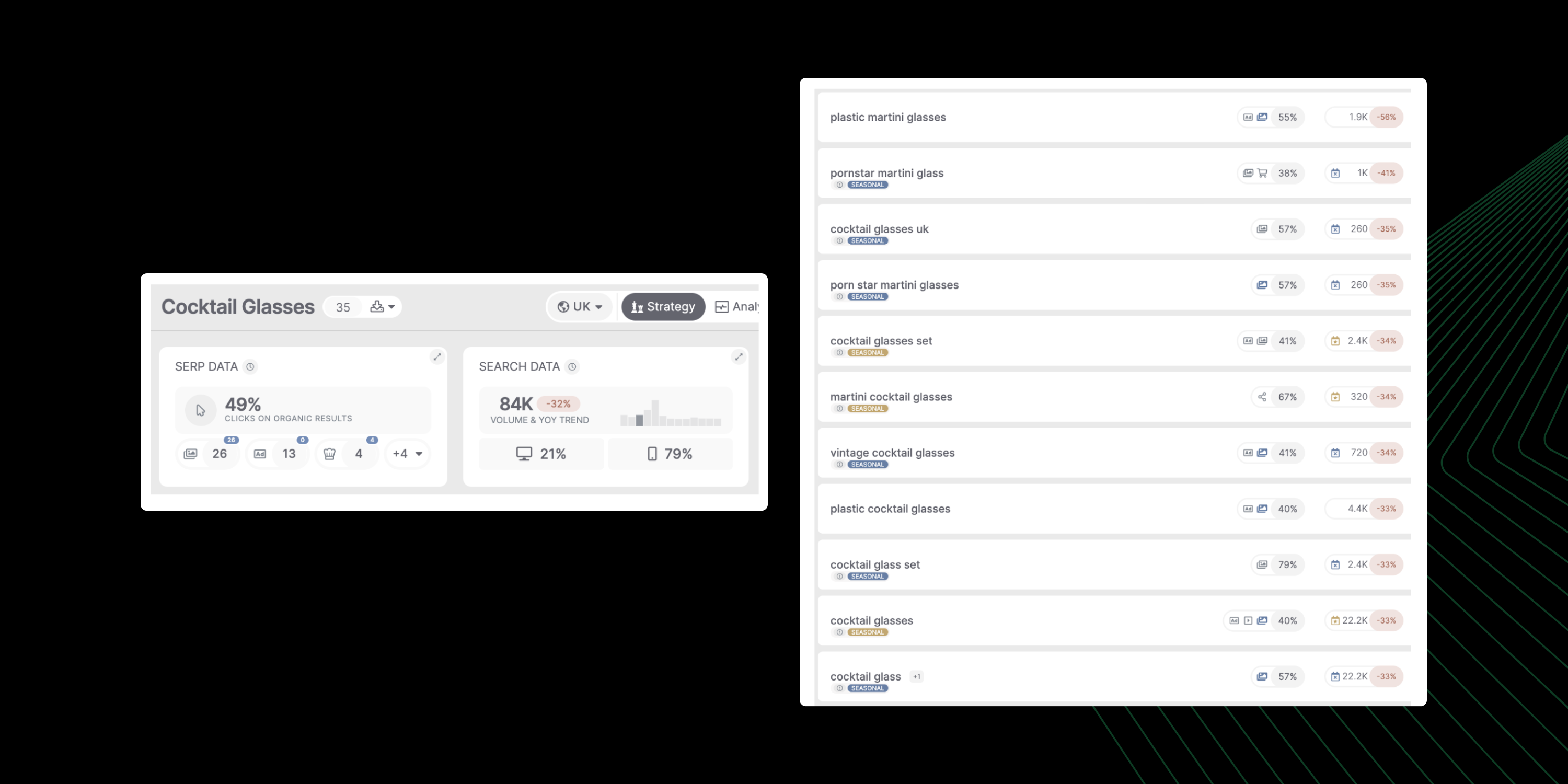Driving growth for your clients is the ultimate goal of an SEO professional – both in terms of traffic and revenue.
Yet, with demand being an even stronger moving target than before, how do you know your SEO objectives are on the right track?
How do you spot a sudden change in keyword search volume trends before it throws your SEO campaigns off the rails?
The last few years have brought changing search behaviors and sudden turns, and the pattern seems to continue as 2022 ends.
We’ve partnered with Lee Dobson, Head of Client Services at Bulldog Digital Media, an eCommerce marketing agency, to discover more about how his agency:
- Uses year-over-year search trends and seasonality data to stay in control of its SEO campaigns.
- Discovered the right level of granularity helps them spot issues and new opportunities.
- Builds trust with client communication.
As Dobson argues, “being able to keep clients satisfied and up to date, especially in recent times and going through a recession, leads to better retention.” And that means constantly communicating about the state of their campaigns and being proactive with solutions.
Let’s discover how Dobson and his team tackle all of the above.
How To Predict Surprise Demand Shifts With Search Data
In the SEO sense, demand shifts are any change that happens to search volume within a normally consistent search trend.
These shifts in demand usually signify that people are suddenly searching more often or far less than usual, and large shifts can derail any SEO strategy you have in place.
During a normal year, expected demand shifts typically occur around holidays or other well-known events when online shoppers and transactional intent searches increase; these consistent demand shifts are called seasonal search volume trends. These can be successfully tracked by comparing your known data, with regular spikes in search volumes. This known data can help you successfully create a full year of SEO campaigns in advance.
Then, there are unexpected demand shifts. These shifts are not as straightforward, as Dobson will show us with his B2B client in the hospitality space – which has had dramatic peaks and drops since 2020.
Since 2020, 12-month-average search volumes haven’t been as reliable in painting the big picture because rapid shifts in demand became the norm. As various industries started recovering, new social shifts created new buying behaviors.
Let’s take a high-level look at the topic of Dobson’s case with hospitality SEO.
Step 1: Use Known Search Data Trends To Discover Targeted Insights
First, it’s important to be able to keep track of known shifts in demand.
Knowing your consistent demand shifts, year-over-year, typically offers an advantage. With this advantage, you’ll be able to consult your clients about where to focus their budgets, what categories to prioritize, and how to maximize their winning strategies.
Knowing those shifts in demand help you visibly see that your SEO campaign is on track. As soon as you begin to see that search volume isn’t hitting predicted markers or new trends appear to be emerging, you may be headed into a demand shift. It’s time to pivot.
And that’s what Dobson and his team did.
In fact, there were quite a few challenges they needed to tackle with a client in the hospitality industry – but seasonality differences were the main focus.
“As a ripple effect of trends since the pandemic hit, seasonality had changed with the various lockdowns and reopenings that occurred. Whilst B2B searches had declined massively, searches for B2C terms had rocketed, with those now looking to make at-home bars wanting to create the atmosphere at home.”
 Image by SEOmonitor & Bulldog Digital Media, November 2022
Image by SEOmonitor & Bulldog Digital Media, November 2022“Fast forward a year, the hospitality industry starts to open up again, and we start to see B2B customers flooding back. Is there anything, in particular, they’re looking for? Could the demand be seen as heightened? Will it fall again? There was a lot of uncertainty, so search data was pivotal here.
Now in 2022, a year with no restrictions, the challenge is how demand has changed again, and even most recently, with the cost of living crisis. Will this now change expectations of the performance of Christmas?”
With average search volumes, year-over-year trends, and seasonality side-by-side, the SEO team at Bulldog Digital Media could intervene fast and advise on the best course of action while managing to answer all questions above.
We could use trend data across all categories to see which product lines are in demand most, quickly pivoting strategy to concentrate on those hot areas to maximize visibility.
Seasonality Trends + Vertical-Specific Data Helps You See Demand Shifts Faster
Apart from the regular seasonal events across times of the year or international holidays, well-known for the ecommerce sector, each vertical has its specifics — some not so obvious, especially when working with B2B stakeholders.
Showing know-how of those specifics with search data builds trust in your consulting abilities, making you a partner and not just the team executing the SEO actions.
That’s why it’s important to have a tool that makes seasonality tracking effective so you focus on the next strategic step.
In SEOmonitor, it’s achieved with automatic labels, making you aware when targeted keywords are approaching peak season or are out of season, thus enabling you to plan content ahead.
Yet, as Dobson’s story continues, it’s all a matter of how all key data points come together.
Step 2: Create SEO Keyword Categories & Easily See Which Sectors Are Fluctuating
To make the data work for you, the right level of granularity is also important.
When it comes to Dobson’s ecommmerce site, they segment their targeted keywords by the category structure, as it’s the easiest way to see how specific areas are doing. This is straightforward and efficient, as the business logic is built into the website’s information architecture.
Plus, being able to track specific priority categories and their section competitors means spotting gaps sooner, so faster decision-making.
That’s why Bulldog Digital Media leverages SEOmonitor’s rank tracker with daily ranking data for desktop and mobile as standard, together with a keyword grouping system that allows them to keep the category hierarchy.
“Because we have all the categories clearly sectioned, we are quickly able to see which areas are seeing sustained, increased or decreased demand using search data.”
How does that look?
“Let’s take the example of the Cocktail glasses category below. We noticed that visibility, on the whole, had seen improvement. Traffic from organic, however, had dropped significantly.
What we’re seeing, in fact, is that demand has dropped significantly, leaving us with a bittersweet win, as whilst we’ve improved our client’s rankings, the desired effects haven’t happened thanks to demand changes.”
 Image by SEOmonitor & Bulldog Digital Media, November 2022
Image by SEOmonitor & Bulldog Digital Media, November 2022Having a tool to bring all the critical data in one view, the team could pull this in meetings with the client to help inform them quickly about the shifts in the market, whilst giving answers as to why traffic wasn’t where they expected it to be.
Step 3: Leverage Tags, Annotations & Transparency To Quickly Discover What Happened & When
Dobson stresses the importance of constantly reviewing and communicating both internally and with the client.
“For B2B, where the hospitality sector was about to have a full summer season, we also could use trend data across all categories to see which product lines are in demand most, quickly pivoting strategy to concentrate on those hot areas to maximize visibility,” he explains.
It was a matter of being structured and transparent from the get-go.
Use Annotations For More Efficiency
To make the campaign management process more efficient, he advises using annotations.
“Within the client’s analytics, we had been adding annotations to key events, allowing us to easily match any quick patterns to events.”
 Image by SEOmonitor & Bulldog Digital Media, November 2022
Image by SEOmonitor & Bulldog Digital Media, November 2022You should think of enhancing the annotation function in every tool in your SEO stack, as you:
- Know exactly what happened and when.
- Report on SEO performance versus external forces influencing the objective.
- Explain the logic and the market to your clients, being proactive about any course correction needed.
Bonus Step For SEO Agencies: Constantly Manage Your Client’s Expectations
With every shift in demand and drop in traffic, Bulldog Digital Media kept the client in the loop.
“Whilst the client had concerns about falls in traffic, using the data and tools at our hands meant we could be proactive to provide valuable insights for their business. For instance, in 2020, one big growth area for the business was hot tub sales, mainly due to weather but also because people knew they’d be spending a lot more time at home. For Spring of 2021, we wanted to monitor closely if we would anticipate a similar uplift, and if not, quickly align traffic and data trends to see if we missed out elsewhere.”
Having this level of agility and transparency, the SEO team could be trusted to direct the business in the right context.
But that also means you have to be honest and report every step of the way. Even when drops occur and the SEO campaign seems to be faltering.
“Feedback was positive from the client, who was able to associate what was happening quickly, but also able to relay internally to help the client be agile with the next steps and align expectations quickly.”
There are many levels that need to align for an SEO campaign to remain on track, so constant reports, over-communication, and fast interventions are key to making sure each side is doing its part.
For some clients, Bulldog Digital Media even includes read-only access in their SEO tool to help them with internal reporting and alignment.
SEOmonitor Can Help You Easily Detect & Fix Demand Shifts In SEO
With shifts in demand happening in faster loops, especially when working with eCommerce stakeholders, it’s not enough to look at search volumes in themselves.
Using year-over-year search trends, keeping a close eye on seasonality, and understanding how the market changes help with making the right decisions and constantly adapting SEO efforts.
Of course, as Bulldog Digital Media explained, it’s also a matter of knowing the client’s business, its strengths, and what the competition looks like for every product or service category.
And having the right level of granularity to know when it’s a problem of performance and when it’s a market problem.
Keeping all of the above in mind, at SEOmonitor, we developed a rank tracker that helps SEO professionals scale. You get:
- Daily ranks for desktop and mobile included in the same price.
- Tracking of all competitors, so you only have to choose the ones you’re interested in.
- Three levels of keyword grouping to easily manage complex campaigns.
- Unlimited users, so you can invite both your team and your clients to the platform.
These are just a few of the features that support clients’ focus on their business growth.
Join us in our journey of building more transparency and trust in and for the SEO industry.
The opinions expressed in this article are the sponsor's own.




